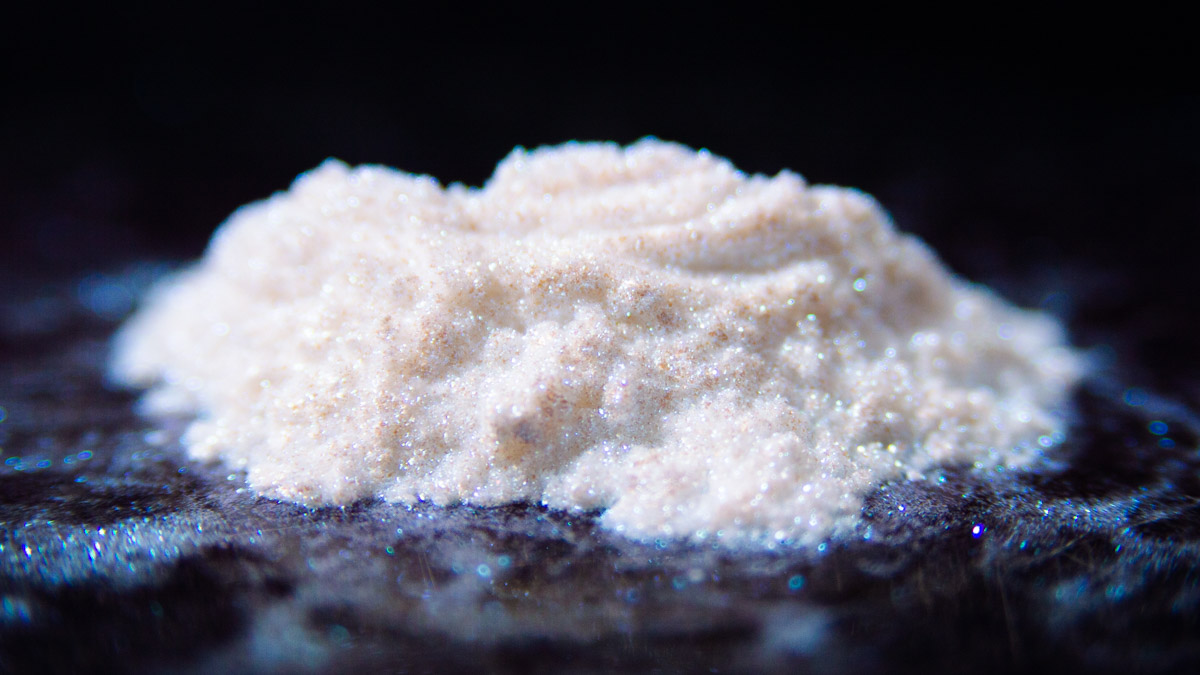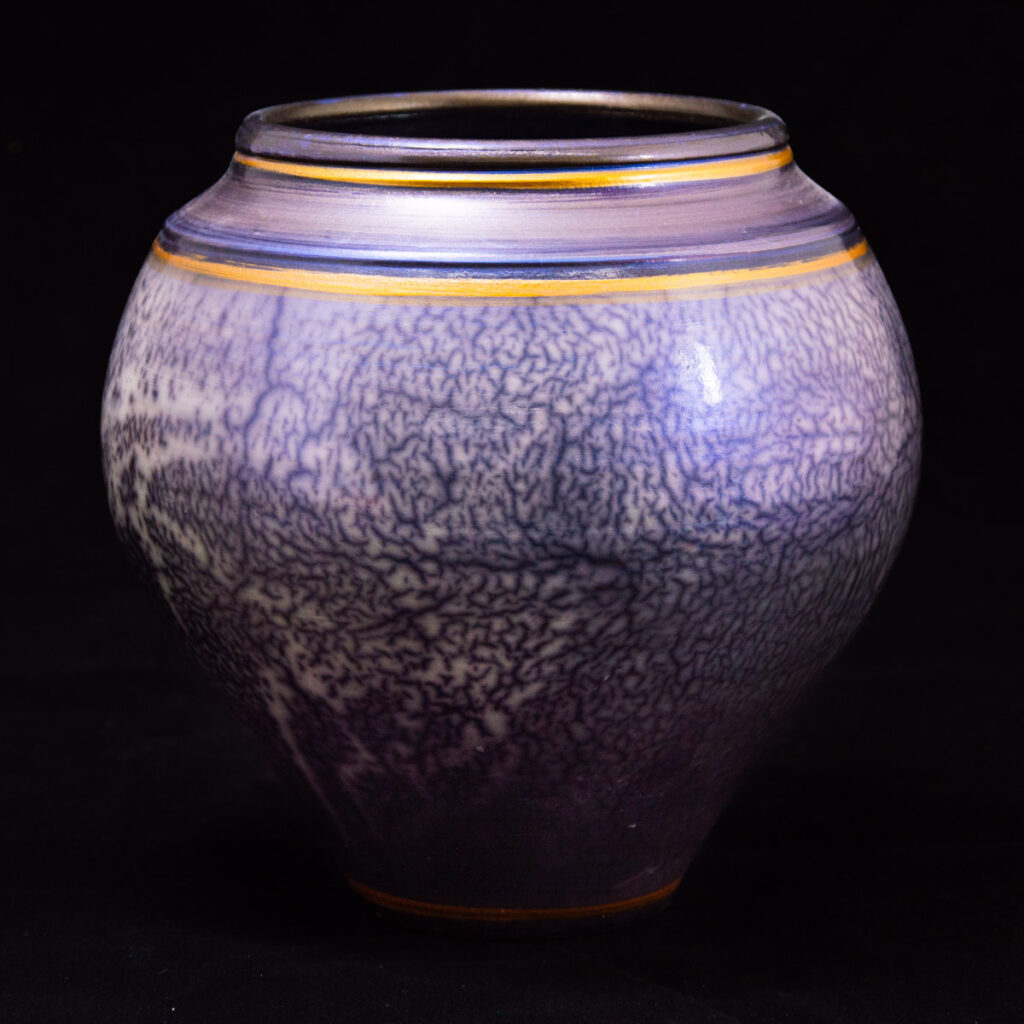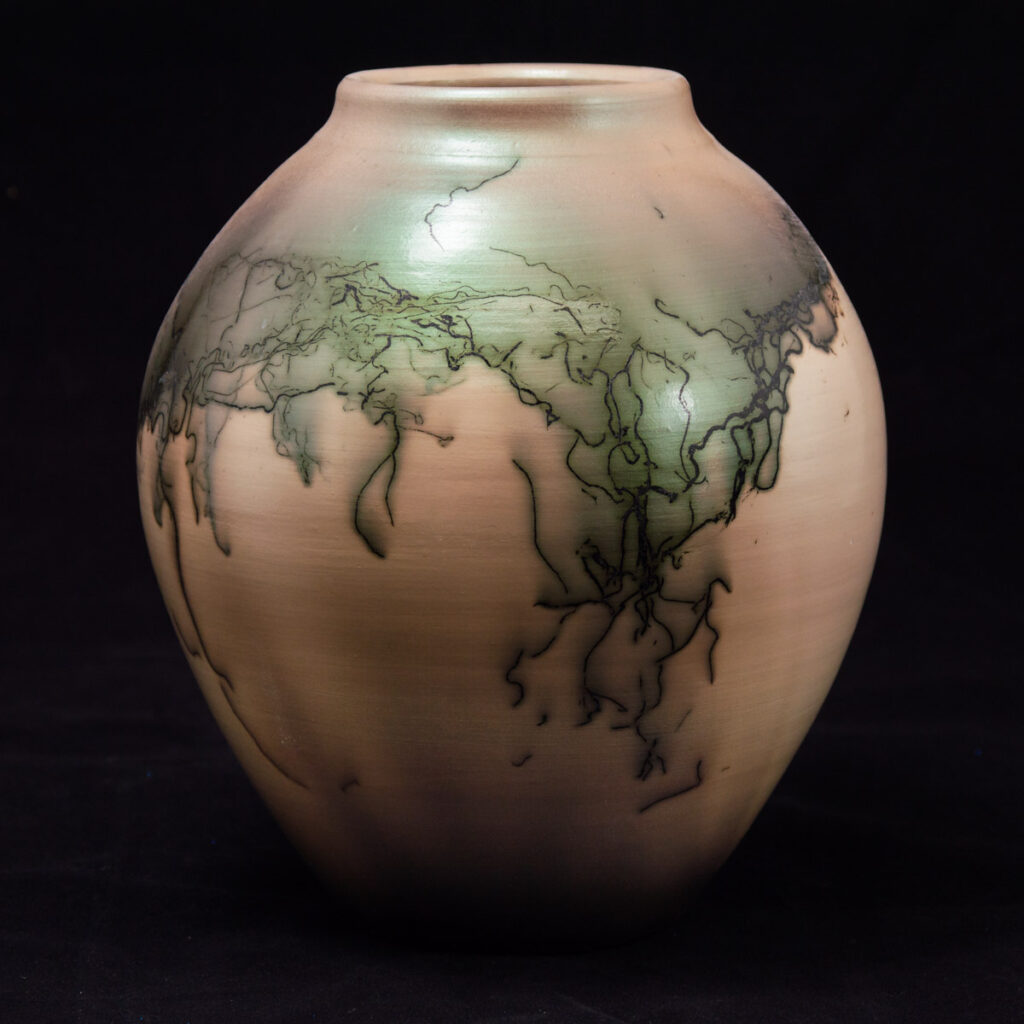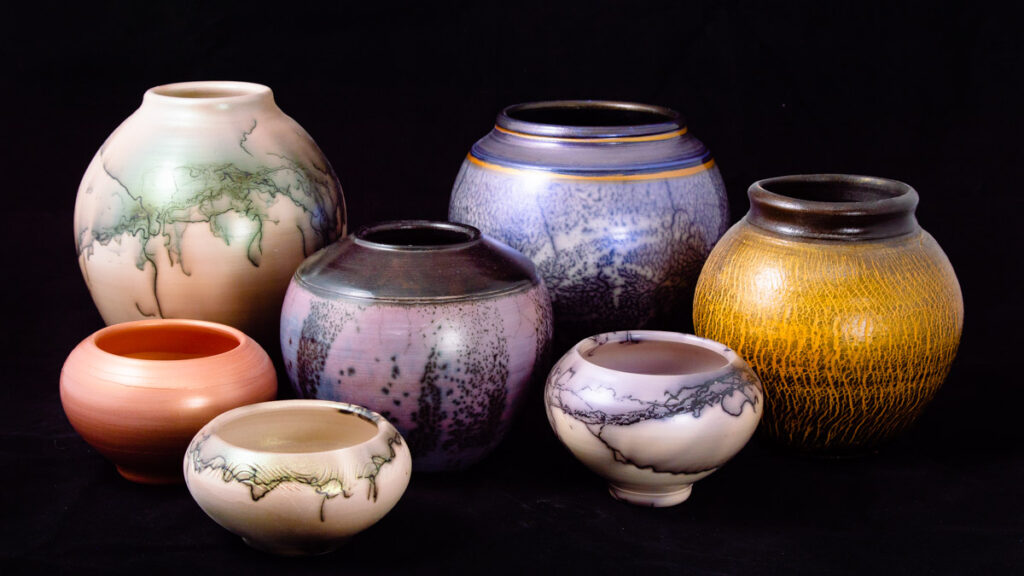MICA INFUSED TERRA SIGILLATA PRODUCT GUIDE
Mica Infused Terra Sigillata
To our classic white OM4 terra sigillata, we added various colors of mica pigment to create a rainbow of metallic and blushing interference colors. We use two types of mica in our mix; Metallic Mica which gives us various opaque colors of gold, bronze, red, green, red green and copper and Interference Blushing Mica giving us shades of white, blue, violet, burgundy, magenta, green, red, gold and copper.
Inspired and mentored by Naked Raku innovators Kate and Will Jacobson, we have created a line of Mica Infused Terra Sigillata. Their ground breaking work with Naked Raku utilizes various colors of terra sigillata and recently mica infused terra sigillata.

Mica
Mica pigments are generally made from natural mica flakes but are also made from specially engineered glasses and silicas. The mica is ground and sorted by size ranging from sub-micron to 200 microns, then coated with oxides such as titanium and iron. Mica particles have a unique flat shape which reflects light, hence the colorful iridescence after coating.
They are commonly used in paints, plastics, printing inks and makeup. As with any fine particle materials a NIOSH approved respirator or N95 face mask are essential when working with the dry mica flakes. Use good studio hygiene.

Metallic Mica colors have a brilliant sheen and are true to color even when fired up to cone 04. They are specially coated to yield a metallic appearance. Fine particle colors give a more opaque glistening sheen, and the coarse particles sparkle more.
Interference "Blush" Micas appear almost white but with a blush of color. They come to show their true colors when there is something black or dark under them. This makes them ideal for any smoke firing process where reduction smoke adds black to the clay surface. Interference Mica flakes are created by coating mica with titanium and then coating with tightly controlled layers of various oxides. Finely ground flakes yield silky lustrous colors and coarse particles add sparkle and brilliance.
Mica colors change after firing, much like glazes. The colors are stable after firing but they lose their color and sheen when fired above cone 02.

What is Terra Sigillata?
Terra Sigillata is a suspension of very fine clay particles in water. Usually white in color, terra sigillata is also made with color additions or with colored clays. It is used as a way to create a smooth dense surface on clay. This happens because the clay particles (3 microns or less) pack together so tightly. When polished, the particles reflect light. These qualities make the surface more reactive to smoke and decorations will have sharp distinct boundaries.
To make terra sigillata, a deflocculant is added to a thin slurry of clay and water and mixed. It is then set aside for 24hrs while the coarse particles settle to the bottom. The fine particles remain in suspension and are decanted off. The coarse material is thrown away. A second settling period for the decanted suspension allows even more of the coarse particles to settle. Once again, the fine liquid is separated from the coarse. The fine liquid suspension is Terra Sigillata.
Terra Sigillata is applied to bone dry pots prior to bisque firing usually with a wide brush. The “sig” naturally shines when applied but is often polished with something smooth such as a plastic bag. To make mica infused terra sigillata, we add a specific amount of mica to the terra sigillata. Too much mica will disrupt the characteristic terra sig sheen.
Directions for using Mica Infused Terra Sigillatas
Mica terra Sig is used in the same way as normal terra sigillata. It is applied by brush to bone dry stoneware, porcelain and terracotta clays. Terra sig will flake off of low fire talc clay bodies. Test your clay to make sure everything is compatible. If a smoother surface is desired a few base layers of regular terra sigillata may be applied prior to the coats of mica sig. Smooth and polish as desired. Mica sig will lose its color and shine if fired past cone 01.

Naked Raku Technique
The Naked Raku technique, as developed and refined by Kate and Will Jacobson, uses terra sigillata on the pottery surface after throwing, trimming and drying. A coat or two of plain sig is applied to make the smooth and white, then a few layers of mica sig are applied. After drying, the pots are bisque fired to cone 017. After bisque, the pots have a coating of Naked Raku Resist Slip applied and when that is almost dry a coat Naked Raku Top Coat is applied over the slip. The pots are then dried to make sure the slip/top coat stay on the ware during the firing process. After their decorative designs are drawn on, the pots are fired to cone 015. Hot pots are pulled from the kiln, cooled for a short period, and then placed in a reduction container to be smoked. After smoking the slip and top coat peel off, revealing black patterns.
Apply a sealer after firing and cleaning to protect the surface.

Horse Hair Raku Technique
Apply terra sigillata and mica terra sigillatas to bone dry ware then bisque fire between cone 017 and up to cone 015. Hotter bisque firing up to cone 06 will yield a stronger pot but will not allow the smoke to penetrate as well as cooler bisque firing will. Lower temperature bisque pots can “take” heat shock better. After bisque, fire up to 1050 F, remove from the kiln and apply horse hair or other reduction materials.
After firing, clean and seal to protect the finish.

Sodium Silicate Crackle Process
To get a cracked and broken appearance on the surface of your pots, Sodium Silicate is applied to a freshly pulled cylinder or slab then flash dried with heat. The dry crispy surface will split and crack as it is stretched and bent.
Before applying sodium silicate, brush on several layers of terra sig then mica sig, or just mica sig directly onto the wet clay. Dry a bit with a heat gun, then apply sodium silicate over the surface. Dry and harden just the surface of the clay with a heat gun or torch. Stretch the slab to get a dry lake bed crackle look or press from the bottom to create patterns. With a thrown clay cylinder the surface is stretched from the inside, pressing out. The further the stretch, the deeper the crackles become.
Alternatively, dry mica can be directly added to the sodium silicate. Use about 7-8 grams of dry mica per 4oz of sodium silicate. Apply directly onto the damp clay, dry and stretch.
Interesting results can come from layering light colors over dark clays or vice versa. The work can be bisque fired, horse haired or just smoked. To horse hair the vessel, refire up to 1050 F and pull from kiln and apply the horse hair. To smoke the piece, refire to at least 1050 F or higher, then reduce in a reduction can or pit for a minute or longer.
Use post firing mica applications to fill cracks with contrasting colors and to embellish the surface textures.
Clean and seal pots after firing. Use good studio hygiene and dust protections.
Terracotta and Sculpture
Mica Terra Sigillata will hold its sheen and iridescence when fired to cone 04. This allows the potter to create pieces utilizing glaze and mica sig. Glaze over mica will cause the mica to lose its sheen and color. The mica sig will not be food safe, as it is just a slip and is porous. Use food safe glaze for eating surfaces and mica for decorative embellishment.
Apply mica sig to bone dry work and bisque fire to cone 06. Apply glazes as desired and refire to cone 06.
Post-Firing Mica Techniques
After firing, additional mica colors can be applied to embellish and enhance your work. Post firing techniques include applying dry mica to fired pots, adding dry mica to underglazes, applying mica terra sigillata over unfired underglazes, mixing mica in to gum solution, and adding mica to acrylic medium or other paint/sealer/glue materials.
Dry mica powder is light and fluffy; suspended in air it readily spreads everywhere. Mix the mica with 10% kaolin and 10% whiting (calcium carb), then add 8-10% jojoba oil. Blend everything together in a ziplock bag until it is crumbly. This will hold the mix together and keep the mica flakes from flying around. Apply the dry mica with a cosmetic brush or with your hands.
Underglaze can be enhanced with additions of dry mica to liquid underglazes. Experiment with the different amounts and sizes of mica. Coarse particle mica will add sparkle and shine. Fine particle mica will add sheen. Fire enhanced underglaze no higher than cone 04.
To add mica Sig to already fired pots, the following technique is an option. Apply underglaze to bisque. When it dries, apply mica terra sig over it. Fire to cone 06. The terra sigillata will bond to the underglaze and will not crack off. This technique also works on higher fired pieces.
Mica can be mixed into CMC gum solution to make a water-based paint. Use 50g CMC powder blended into 1 liter of hot water to make the solution, or purchase liquid gum solution from your supplier. Mix dry mica powder with 10% kaolin and 10% whiting (calcium carb). Add the mica mixture into a small amount of the gum solution until it is the consistency of paint. Apply full strength or diluted. Brush into the texture and wipe off for antiquing or spread around to color other areas. The mixture holds the mica flakes so they do not fly around.
Apply spray acrylic to seal and protect the surface after application. Water based sealer will dissolve the mica gum solution. If you need to revise your work, it can be washed off before sealing. It may also be applied over a sealed surface and then sealed again.
Mica can be mixed into acrylic medium or other sealer to make mica paint. Use as paint or wipe back for antiquing and highlighting. Small amounts of mica in acrylic sealer can be used as a tint or wash.
Sealing Your Pottery
After cleaning and drying your finished work use acrylic spray, liquid acrylic medium or waxes to seal and protect the surface. Common acrylic spray brands include Duncan, Krylon, Liquitex and Rustoleum. Liquitex clear medium and varnish as well as other liquid acrylics are another option.

